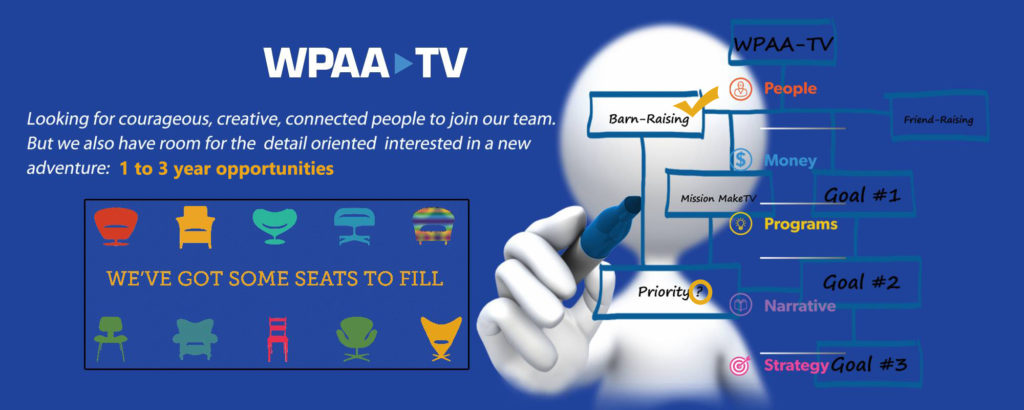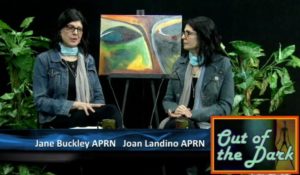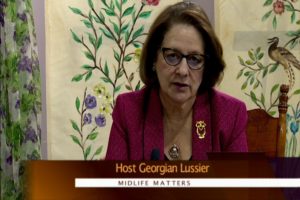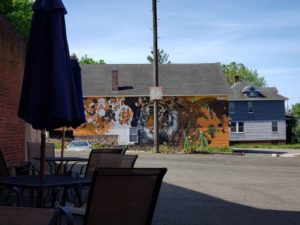It would be nice to have subscriber and viewer data to understand who we are fighting for.
Our Bones Are Good Internet Connected World
In an Internet connected world, can or should Community Access TV, as we know it, be sustained? Yes and No.
Everything this experiment in democracy has at its core remains a vital part of sustaining democratic communities: building community through the production of ideas, opinions, stories, news, information and/or performance while valuing free speech, individual expression, inclusion and diversity. There is no comparable network of local organizations dedicated to being ‘of, by and for’ the voice of the people. If seen collectively, it is the largest television network in America. However, it is not a monolith. As a network, Community TV stations, many organized through the Alliance for Community Media, have shared principles, values and leaders that keep them from being rudderless, but they are as different as they are alike.
The Internet’s potential for worldwide connectivity provides many opportunities for expression and the possibilities may include a variant on this experiment someday. But thus far there is no Web amalgamation of local entities that is anything like community TV. As an experiment, it represents the diversity of America. It engages people agreeing and disagreeing about what makes a difference to them locally where they still have the potential to influence outcomes.
Yes, the Internet changed Community Access TV as it has many aspects of daily living. The Internet provides the infrastructure for a variety of information collections and services within the World Wide Web. For Community TV it is another tool for content delivery.
If the Internet is ubiquitous and free to all Ignoring those pop up ads and digital divide will the eroding uniqueness of local television still be desirable as local television?
• Comfortable watching of content from a living room recliner Smart TVs already let you view YouTube this way;
• Sharing the same viewing experience as your neighbor Smartphones already let you share links to what you want others to also see;
• Community projects bringing folks together to tell community stories The social distancing pandemic has made virtual meetings a mere calendar entry away;
• Commercial-free viewing Assuming the local station is not infiltrated by self-promoters; and
• Hyper-local media that is not controlled by corporate media But may be captured by self-appointed power brokers.
For now, Cable TV Community Access is a delivery system for hyper-local content: content important to the shut-ins who cannot attend church Who are not Internet savvy, commuters who cannot attend a public meeting Although they are likely watching a replay on the Internet, a child proud of his/her report or talent as it is shared with everyone in town, immigrants learning a new language as they listen to the same news stories in two different languages, or new homeowners eager to learn about their community.
Few singular events change a world view. Before the COVID-19 pandemic, I believed that what the Internet could not be, or easily replace, was the potential to meet and gather in person, teach, discuss and share what is local based on the reasonable needs and interests of a community. Then the socially starved world experienced the rise of the racial justice movement in rallies, protests and online conversations creating more community engagement opportunities than community TV could envision supporting.
2020 has been nothing but evolutionary, eclipsing 1965: the bridge in Selma Alabama, the race riots in Watts, The Voting Rights Act, Vietnam War, Medicare, the Gemini Space Program, Mini-skirts and CT imposing a 9% Gross Income Tax on cable companies that was still being adjudicated in 1990 before the FCC.
Social distancing and essential business guidelines made some community TV stations go dark temporarily, or become a platform for archival reruns or virtually attended message boards, or as was the case for my station, busier than ever as essential media. Essential media stations assisted with online graduations, extended redistribution of online faith-based gatherings, and repurposed online community conversations into digestible resources. New content included fitness programs geared toward the silver sneakers generation and a children’s storytime in the late afternoon.
As people gather virtually, there is a palpable hunger to engage in person. So what is the real and future need for physical spaces to make media? There is a need for youth to discover, learn and experiment interactively with technology, and elders to stay connected inter-generationally in a public space. Locally WPAA-TV and Community Media Center is preparing to be that public space. We are not yet all we can be but our bones are good.
Juneteenth Guest Blog| to Freedom …
Juneteenth to Freedom, My Grandmother and Me

“Let’s go, Alease!” my grandmother who I am named after would yell as she put on her apron and walked into the kitchen at our home in Crown Heights, Brooklyn. It was always hard to pull me away from my favorite after school cartoon, DuckTales. “I’m coming, grandma!” I politely and respectfully yelled back to let her know that I was on my way.
It’s June 19, 1990-something and my grandmother, Alease Whiteside (I’m Alease Annan) and I are preparing for our grandma/granddaughter cook-a-thon to prepare for her annual Juneteenth Freedom Dinner.
In our house Juneteenth was a big deal—a really big deal.
As a Black woman, who came of age in the 1980’s and 90’s, I have undoubtedly experienced racism and discrimination. My grandmother, however, grew up in the Jim Crow American south in the 1920’s and 30’s experiencing, witnessing, and feeling a level of hate and racism that I cannot imagine.
My grandmother never explicitly outlined the terror and discrimination she experienced growing up for fear of scarring me but I could see it. I could sense it.
Through her pain though, there was incomparable beauty, immense joy, Vogue-like style, and unmatched skill when it came to the culinary arts. Simply put, my grandmother could cook.
Sweet potatoes. Cabbage. Collard greens. Salmon steak. Turkey wings. Mashed potatoes. Fried chicken. Potato salad. String beans. Macaroni and cheese. Yellow chocolate cake. Chocolate chocolate cake. Sweet potato pie. Cornbread. “I know I’m forgetting something. What am I forgetting?” my grandmother would ask me. Always wanting to be helpful I excitedly said, “Banana pudding, grandma!” She would gently cup my face with a sweet smile as a sign of approval that I had done well.
As I meticulously tore the ends off each string bean, careful not to take off too much, my grandmother would talk about Juneteenth and why we celebrated. “As my mother would tell me and her mother’s mother told her, Juneteenth was the day we received our freedom. It’s a way to honor my grandparents, and my great-grandparents, and my great-great grandparents who were slaves. Their sacrifices are why you, your mom, your uncles, and your cousins are here. We must honor the ancestors. That is why we celebrate.”
I think my grandmother’s Juneteenth definition is great but I’m biased. Here’s how Wikipedia explains Juneteenth: “Juneteenth (a portmanteau of June and nineteenth) is an unofficial American holiday celebrated annually on the 19th of June in the United States to commemorate Union army general Gordon Granger’s reading of federal orders in the city of Galveston, Texas, on 19 June 1865, proclaiming that all enslaved persons in the U.S. state of Texas were now free.
Although the Emancipation Proclamation had formally freed them almost two and a half years earlier, and the American Civil War had largely ended with the defeat of the Confederate States in April, Texas was the most remote of the slave states, with a low presence of Union troops, so enforcement of the proclamation had been slow and inconsistent.”
As I got older and learned more about America’s deep seeded history of segregation, racism, and oppression, I proudly continued my grandmother’s annual Juneteenth celebration. The menu was much, much, much smaller but the amount of love and commitment to honoring the tradition was the same.
In light of the murders of George Floyd, a Black man killed by police in Minneapolis, Minnesota, Breonna Taylor, a Black woman killed while sleeping in her bed in Louisville, Kentucky by police, and Ahmaud Arbery, a Black man killed by criminal vigilantes while out for a jog in his Brunswick, Georgia neighborhood, America is experiencing a New Civil Rights Movement that has inspired people all across the globe to rise up and stand against racism and oppression. Legislators have taken notice and started implementing police reform measures as well as strategizing pathways to dismantling the policies and systems that adversely affect American citizens who happen to be Black Indigenous People Of Color (BIPOC).
In a historic move, Virginia Governor Ralph Northam declared Juneteenth a state holiday on June 16, 2020. “It’s time we elevate this. Not just a celebration by and for some Virginians but one acknowledged and celebrated by all of us,” Northam said. New York Governor Andrew Cuomo followed suit the next day and Texas declared Juneteenth a state holiday in 1980. Additionally, there have been efforts in Congress to make Juneteenth a federal holiday.
From Juneteenth in 1865 to Bloody Sunday in 1965 to today in 2020, we’ve been fighting for freedom. With the global movement for Black lives and human rights, you can hear Black Lives Matter chanted in Berlin, Spain, Amsterdam, Ghana, Paris, Brazil, South Africa, Kenya, London, Syria, Bed-Stuy, to the Upper East Side, to Boston, to Portland, and every state in between.
Through it all, My Black is still filled with 2008 Hope. My Black is proud, and smart, and fearless, and joyful, and all kinds of badass. My Black honors the ancestors and my incredible grandmother who taught me the importance of love, soul food cooking, and Black history. My Black is boldly marching and working to effect real change so that we’re not just freeish but FREE.
JUNETEENTH FREEDOM DINNER RECIPES
Were you salivating reading my grandmother’s Juneteenth Freedom Dinner menu? I was, too! I wanted you to be able to make your own Juneteenth meal, so I reached out to Chef Paul Austin, Owner and Head Chef of The Missing Ingredient catering and he graciously agreed to share his Rosemary Chicken, Roasted Baby Vegetables, and Roasted Corn and Black Bean Salad recipes. Chef Paul is fantastic and has a special connection to BRIC as he has catered our B Free Awards many times. Enjoy!
Recipes: Rosemary Chicken Roasted Baby Vegetables Roasted Corn & Black Bean Salad
Board President Statement Joey Allard (2019)
I, Joey Allard, had the opportunity to be a leader and a learner while serving WPAA-TV as President until June 2019. My three-year term on the board is up in a few months but I have never been more proud to be a part of WPAA-TV. Looking back at the challenges we faced we have come a long way.
Discover Us: As a board and an organization, we have worked hard to get people in the doors. We have done everything from handing out candy on Halloween while filming a live Halloween special to running a film festival for the town to participate in. As a board, we evaluate what works and try to execute it better the next time. Being a part of an organization that runs primarily from volunteers is not easy. We have had board members disappear with days’ notice, members and crew of productions stop showing up and struggled to get new volunteers in the door.
Our primary goal was to connect to our town and show them the importance of Public Access. This has not been easy due to the lack of support from town officials who don’t see a value in Public Access. As a board, we have found this came out of not understanding what we are and what we do.
Social Media: Over the years, we have really made strides to put ourselves out there to our community through the use of social media. Through the day to day interactions with our social media account members of the community have become friends with our organization and began to view our content as well as participate in discussing involving current events happening at the station, programs, things happening in our town, and most importantly free speech.
Leadership is with a Team: All these factors forced our board to grow together and strengthen as we were the foundation of the organization and its key support system. Being a part of an organization that helps provide a voice and support free speech to our community has been a true honor. As our community relationships have grown and people have seen the impact we can have with one another.
Support New Leadership: My term as President ended but #wpaatv still has a long road and challenges ahead. As I look back I see the mountains we have already climbed and had no worries about our success. As I move forward I will continue to support and fight for public access on all levels throughout our community.
I Am Here For A Reason
For me the recycling of digestible speeches and non-threatening quotes is patronizing.
No, it is not existential anxiety, although it could be. I skip the few hours of songs, stories and speeches intended to commemorate the life of Dr. Martin Luther King Jr. at Wallingford’s Town Hall which I have attended thrice since 2002. It is now 2020 and once again I decide to go elsewhere, seeking relief from the superficial ubiquity of quotes.
As I understand it, until 2002, St. Paul’s Episcopal Church in Wallingford was on the front lines of commemorating Dr. King’s legacy since Martin Luther King Day was enacted into law in 1983 as a Federal holiday.
Anyone peripherally familiar with my town might assume my disquiet is a hangover effect from the town’s very public controversy in 2000. This controversy was seen differently by life-long residents, newcomers, city leaders, union representatives, churchgoers, and young people my son’s age including my son, Houston. Amidst the very public turmoil, I get some video footage of Jesse Jackson speaking at our Town Hall. Reverand Jackson reminds us that he was with King the afternoon of his death.
In 2018, my community television station unexpectedly expands my understanding of this historic day in the local arena.
Beth, a life-long resident, decides to contribute to a show called CommUnity Conversations that brings two people together to share a topic from their individual perspective. Her first topic is Race in Relationships. Beth brings her new friend KiKi, a person of color, to WPAA-TV for a few conversations on their experience of being friends. In the very first three minutes of the conversation with KiKi, Beth weaves together many loose ends for me and illuminates my sentiment I am here for a reason. She affirmed I am indeed doing justice work. Beth’s story, in mothballs for decades, would otherwise never have seen sunlight. I consciously use a video clip from this conversation in our 2018 Video Annual Report.
The 25-second trailer soundtrack of the 20-minute Annual Video Report is as follows:
I’d be happy to share my story.
Almost on queue you hear crash.
Erin it’s back to you.
If we didn’t see a need …
I’m always hopeful.
I asked the magic question …
You can now go on your phone and register to vote.
What would you say is the take-home lesson from our story?
I wasn’t aware that the Ku Klux Klan was in Wallingford.
Cut.
Each segment begins, “Welcome to our CommUnity Conversation,” and then the conversation continues with whatever the contributors decide to say.
“I am Beth. This is my friend KiKi and we will be talking about race in relationships today. So, for me growing up in Wallingford,” Kiki nods and affirms, “Right.” Beth searches for both her memory and courage This video will be seen in Wallingford, after all. She continues, “which was (hesitates and starts again) at the time the clan was very predominant. You’d walk down Center Street and you would see, you know, the sheets. Going to the corner store they were there. You would see the black hearses, Beth gestures as if outlining the route, coming down with the clansmen. They would go into this graveyard.” The iconic symbol of our town’s history. Again she describes the scene from her childhood before mentioning her feelings. “Umm, across from where the pizza place is AND I JUST REMEMBER STANDING THERE AND THE FEELINGS THAT IT GAVE ME. Some fear. Because no one ever really talked about it. Because nobody knew who these people were.”
KiKi asks, “And so you didn’t know,” they simultaneously say, “who they were?” Beth continues, “I didn’t know who they were. They were just these men in these sheets. It wasn’t like an open dialogue that we would have in the community. It was not like it would (casual gesturing) be like What’s up with this? It was just, you saw them. You kept quiet. You did not talk about what you felt. You did not talk about how it made you feel.”
She continues reflecting on this moment that does not come fully into view with some justification.
“And I know I was pretty sheltered and I grew up and everyone was the same color. Everyone thought the same way. The values! The morals! Everything was exactly the same! I did not have a lot of friends that were black. I never had the chance to communicate with anyone outside of my own race. I remember very distinctly there was a (she pauses and restarts) In Wallingford at the church near Archie Moore’s this being St. Paul’s Episcopal and Jesse Jackson had come in. And it had something to do with Martin Luther King Day, and (pause) what ended up happening is we had this (pause) I do not want to call it a protest but it was a march to the Town Hall. So we walked into the church and the clan was outside and they were all like lined up and they had their speaker with their microphone.
Let Me Interrupt with My Distraction
My phone buzzes. Its screen fills with Twitter news posted by the local paper. I am immediately jolted back to the present, 2020. I pause the video I am watching to ingest the news In Wallingford, technology eliminates need for police couriers. This breaking news is about the use of email to conduct the town’s essential business. It reports a new development that is only news because of our Mayor’s disregard for technology One of my pet peeves. The tweet reports on the absurd delay in the use of email replacing use of police couriers Email was created about the time of King’s assassination after all. The police will no longer be Town Council Meeting document couriers. For years, the Wallingford Police Dept. reported staff shortages in several budget workshops but continued to lose hundreds of man-hours each year to be used as postal couriers getting documents to Town Councilors in preparation for their meetings. Documents that could have been distributed via email decades ago. Notably, the distribution will be from one of the few email addresses associated to the town government to the personal emails of the councilors.
My personal Twitter feed describes me as a “community media frontline volunteer: discovering, capturing, producing & sharing stories to keep the engines of service & democracy going in my town #W06492.” From this vantage point, I re-tweet without comment and leave this distraction like so many in my day.
I Am Here
I take the video off pause to hear Beth recall, “They had their speaker with their microphone and they were yelling profanities and all types of things. And I remember walking out and standing there at the top of the steps where the church is and looking out and seeing them. And I remember shaking a little bit because they scared me.” She reiterates the awareness and the secrecy, “I knew nothing about them because it wasn’t something that we ever talked about But she wanted to talk about it now. Her friendship with KiKi emboldened her to reveal this childhood fear. KiKi picks up the conversation likely sensing the timeline was unclear. “How old were you when you first experienced the clan?” Beth replies, “I want to say as young as ten.” That would put her early experience roughly in the year that MLK Day was signed into Federal law.
This CommUnity Conversation happens in early 2018. Beth is now 45. She continues, “When we were doing that march I had to be in my mid-twenties.” When I hear this clarification I realize Beth and I were at the same event, differently. Beth would have been closer to 26 and a life-long resident of Wallingford. Me? I was here as a relative newcomer with angst about what my 14-year-old was experiencing in this town with headline news about this town in an Internet-connected world. One thing I do know is that when he traveled and performed at poetry events he referred to home as New Haven, the place he was born, not Wallingford, the place his mother bought a house.
Wallingford was the last municipality in Connecticut to close municipal offices for the Martin Luther King Federal Holiday. It was national news My AmeriKKKan town. Shamefully, it took a state law to move the pressure needle on the civil rights gauge here. There was much cloaking by the Mayor of underlying truths as he pitted poor elder taxpayers and unions against what was right In my opinion. That may be the year the voice in my head began telling me “You are put here for a reason.”
From #CitizenMediaMaven_TheLife Chapter I Am Here For A Reason
Hercules Arrived in the Neighborhood 5 Years Ago
Public Art has a whole new value in the time of Covid-19, at least in this tiger’s neighborhood. But we always knew it was a destination spot. Even Triple AAA agrees.
What are the Responsibilities of a Board Member?
The Basics
- Attend six meetings that focus on oversight and strategic direction of the organization
- One of these is the Annual Celebration of Voices. Dinner, Conversation and Look Back
- Participate in at least one committee: Outreach, Building, Tech
- Or, Participate in an Initiative: Information Literacy, Civics Literacy, #SocialActionArt, Community Media Day
- Attend committee meetings and attend to the tasks identified by or for those committees
Preferably, commit to a three-year term to increase the potential for WPAA-TV to serve the community.

Very Helpful
- Network to increase awareness of WPAA-TV
- Develop connections for viewers, users, and future financial supporters
Current Needs
We always need people with roots in the community. Key functions that need support are finance and marketing. In particular, one volunteer is needed that can onboard for the Office of Treasurer. The strategic initiative is outreach to engage grassroots to discover us, view, participate and fund Freeman’s Purse. $5 a year from 4,000.
Reminder: Involvement in the production of shows is not a board function, so do not infer this to future members.
Out of the Dark: Looking at Mental Health through practiced eyes
By Garrett Amill
Mental health issues are still stigmatized. Addiction, PTSD, and more are rarely understood, let alone talked about. Out of the Dark takes a shot at addressing these complicated issues. It succeeds at shedding light on them through frank discussion.
The hosts, Jane Buckley and Joan Landino, are twins. Despite looking nearly identical, they are far from the same person. They have different takes on issues, and sound very different from each other. It is easy to tell which one is speaking, even if you can’t see them.
The two are both APRNs, or advanced practice registered nurses. This means they have more training and expertise than other nurses. This expertise lets the two discuss mental health issues from a perspective that includes more scientific knowledge. Of course, being nurses they see more cases of mental illness than the average person would. That on the street experience gives them further perspective on the issues.
 The hosts’ experiences work to provide more information than otherwise. However, their discussion never gets too technical. Everything they say can be understood without a background in medicine.
The hosts’ experiences work to provide more information than otherwise. However, their discussion never gets too technical. Everything they say can be understood without a background in medicine.
The mental health challenges they chose to discuss are relevant. Dementia care, addiction, and marijuana especially provide good opportunities for interesting takes from the hosts. There are also a few less controversial episodes. The episode on DNA guided medicine is a particular standout. If you haven’t heard of that concept, definitely check it out to learn something new and fascinating.
A frank look at mental health issues is rare, but Out of the Dark provides it, bringing light to these often ignored issues.
Citizen Mike: a service to the town and a lot of fun
By Garrett Amill
The most important part of government can be smaller than you think. Local politics often have just as much of an impact on life in a town as state politics do, or even federal. There can be a dearth of information about local politics, however.
Citizen Mike acts to fill a gap in Wallingford, providing a place for debate and discussion of goings-on in the government of Wallingford and beyond. Citizen Mike hosts government officials and employees. The show also features people with opinions on aspects of the town, like a teacher to talk about Wallingford schools.
Besides providing a service, the show is compelling to listen to. Much of that comes from the skill of host Mike Brodinsky. Brodinsky has an understated charm to him. He could easily be the center of attention on the show, but instead, he lets the guests shine.
Brodinsky asks questions well, getting the information from guests that he knows listeners will want. At the same time, he keeps the guests from rambling too much. Brodinsky also has a good knowledge of what will get too technical for the audience. He asks guests to clarify what they mean whenever they use jargon or reference things the audience won’t know.
 Citizen Mike is a very timely show. It’s been the first source for information on newly announced decisions in the past. This makes listening to older episodes less ideal, since they can be about old news. However, some of the show’s episodes have a longer shelf life.
Citizen Mike is a very timely show. It’s been the first source for information on newly announced decisions in the past. This makes listening to older episodes less ideal, since they can be about old news. However, some of the show’s episodes have a longer shelf life.
Citizen Mike provides a service to the town of Wallingford while being interesting to watch. It functions as a fascinating local political news show.
Midlife Matters: Cozy, yet full of wit
By Garrett Amill
I never thought I’d care about the art of Ukrainian egg dying. Hearing it discussed on Midlife Matters, however, my attention was nowhere else. Midlife Matters manages to make topics I’d never heard of interesting.
The host, Georgian Lussier, brings a calming presence to each show. From the owl sounds that play at the start of the episode to her voice throughout, there is a contemplative tone.
The guests are all women,  and all over 40. These women provide unique perspectives. An episode featuring a teacher from an automotive trade school is made better by that teacher being female. The fact that a woman can teach in a male-dominated industry is empowering.
and all over 40. These women provide unique perspectives. An episode featuring a teacher from an automotive trade school is made better by that teacher being female. The fact that a woman can teach in a male-dominated industry is empowering.
None of the episodes are truly run of the mill. Even the ones that seem that way at first turn out to be worth listening to. One episode on a grief support program has an especially interesting guest, who clearly has a life full of stories to tell. Lussier is capable of letting her guests tell their stories while making sure those stories stay interesting.
The start of shows can drag a little as Lussier finds her footing with the guests. Once she does, however, the conversation flows. It’s worth listening to get to the fascinating discussion.
Midlife matters provides a contemplative look at what is fascinating in the lives of women in the area. It’s a good show to watch while drinking a cup of tea and taking in a unique world.


